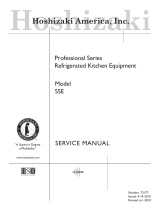
c) Comp and CondFM Diagnosis: Confirm Comp and CondFM energize after the
3-min. of delay at the power on. If not, check if the compressor icon appears in the
remote display, if not check the set point and the temperature in the remote
display, if the temperature is not in proper range check the CTh status. See "II.D.
Thermistor check”, If CTh ohm reading is in proper range replace controller.
If the compressor icon appears in the remote display and the set point and the
temperature in the display is correct, check If 115VAC is present at the controller
terminals #5 (Black Smooth) and #7 (White) If 115VAC is not present, check if
115VAC is present at controller terminals #4 (Black Striped) and #7 (White), if it is
present replace the controller.
If the CondFM is energized but Comp is not, check for 115VAC at Comp thermal
protector and neutral (White) in the compressor. If 115VAC is not present, give
time for Comp thermal protector to cool and reset. If Comp protector does not
reset, replace Comp protector. If 115VAC is present, check Comp start capacitor,
start relay, and Comp motor windings. If CondFM is not energized, check ConFM
fan blades for binding and motor winding continuity.
If Comp and ConFM are energized and the cabinet does not cool down, check for
a restriction in the refrigeration circuit, check the suction pressure, and correct
refrigerant charge, see "VIII. Technical information".
8) Cool Down Achieved-CTh cools to Setpoint of 32°F (0°C). EvapFM continue on, Comp
and CondFM de-energize. Diagnosis: Confirm Comp and CondFM de-energize. If not, and
Comp and CondFM were energized longer than 3-min. check if the Comp icon in the
display is off, if the Comp icon is present, check the set point. Check the CTh status. See
"II.D. Thermistor Check" If CTh ohm reading is in range and Comp and CondFM continue
longer than 3-min., check for 115VAC at the controller terminals #5 (Black Smooth) and #7
(White) If 115VAC is present replace the controller.
9) Defrost. There is a 25-min. defrost time each 6-hr. after power on or energy restore.
1b) Manual Initiation: To initiate a manual defrost, press and hold the snowflake
button for 5 seconds. The snowflake icon appears in the display. EvapFM and
LampSW continue energize Comp and CondFM de-energize. The last
temperature on display is holding during the defrost time (the temperature do not
change on the display during defrost time).
2b) Manual Termination Defrost: P
ress and hold the snowflake button for
5 seconds, the snowflake icon in the display must turn off, and the compressor
icon must be blinking in the display, 3-min. Comp delay timer starts, after the
delay timers terminate the Comp and CondFM energize.
























